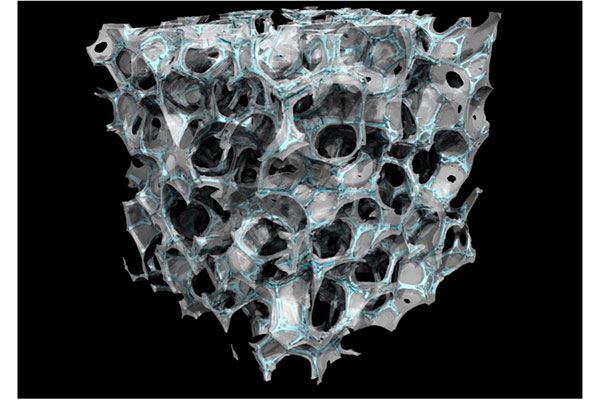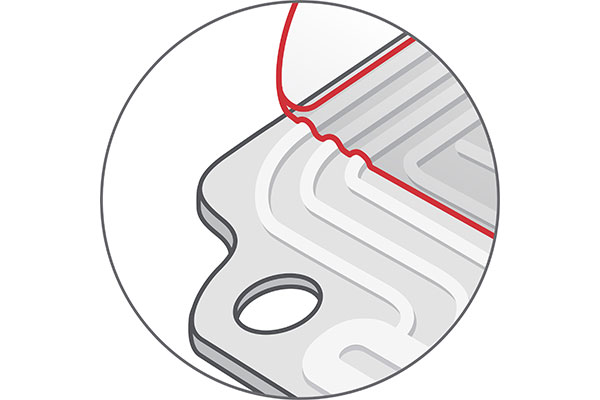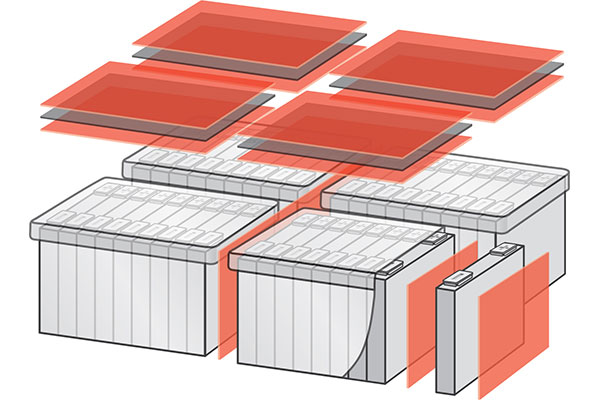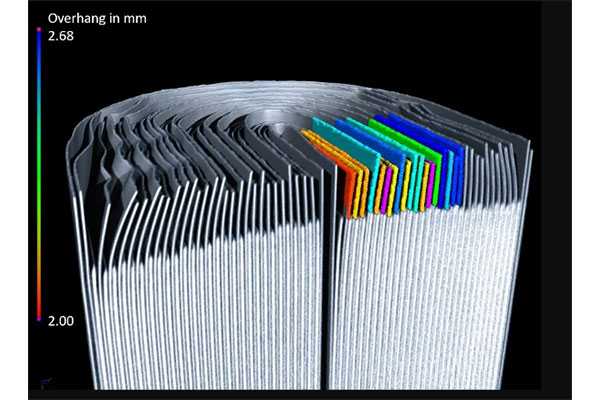Building a Better EV Battery
As the advent of electric vehicles takes shape globally, battery design takes center stage as a technology to watch, especially as more electric vehicles are produced and go on the road.

Ceramic foams are potential candidates for electrolyte material in future solid-state batteries. Due to the replica manufacturing process, there are thin channels within the struts (blue). Image courtesy of Volume Graphics.
Latest News
January 26, 2023
Electric vehicles are moving upward and outward on the technology adoption curve, driven by societal pressure to find more sustainable sources of power, especially for automobiles.
Advancements in the development of electric vehicles (EVs) have accelerated the demand for battery technology. However, several challenges still persist around the design and production of EV batteries that engineers must be aware of, and eventually reckon with.
The EV Battery’s Critical Role
“Batteries continue to remain the most critical component in EVs accounting for 40%-50% of the overall vehicle cost,”says Sidhant Rastogi, an automotive expert and managing partner at Zinnov. “While advanced versions of Li-ion batteries are safer, smaller and store more energy for their size and weight, companies are actively exploring alternative battery chemistries, permutations and combinations to make EVs safer.”
For example, Zinnov points to how Tesla plans to eliminate Cobalt from its batteries. Meanwhile, other companies are replacing graphite with silicon, or developing sodium-ion batteries. Investments in solid-state batteries by companies including SolidPower (SLDP) and Toyota Motor (TM) are increasing, thanks to the promise of higher energy density, faster charging and lower fire risk.
Various battery features will be the focus of new and innovative designs as performance and production costs become a key factor in competing globally for the EV battery market.
“Today, the battery industry is mostly focusing on new chemistries and pack design efficiencies,” says Xiaohong “Shawn” Gayden, CEO of Intecells Inc. in Troy, MI. “The conventional electrode coating process uses a slurry coat and dry technology. This costly, carbon-intensive process requires a skilled workforce with deep know-how currently dominated by Asian battery manufacturers. Solid-state batteries are likely to drive up manufacturing costs, making mass production difficult to scale. Efficient pack designs (cell-to-pack) have limited short-term benefits without real breakthrough in battery cell manufacturing.”
Innovation Emerging
Future battery cells will be made using many new and unexplored technologies. Everything’s on the table as far as materials, chemistry and the characteristics of design. Avery Dennison, the label maker, which also makes high-performing tapes and films, has some design perspectives worth pondering.
“As a tape provider, we’re laminating functional materials within the battery pack in different ways to achieve singular properties that engineers require,” says Max Van Raaphorst, business development of e-mobility and automotive for Avery Dennison Performance Tapes North America. “High-voltage materials run through a constrained area that contains metal, and you need to prevent that from arcing. Adhesive tapes incorporate dielectric films that provide necessary electric insulation for sensitive EV battery components. The tapes also bond in materials like Mica that have dielectric protection.”

He also explains that one of their tapes, F4-rated tapes, meet thermal runaway specs and allow engineers to bond various battery aspects together quickly to lessen flammability. A compression pad to manage firmness, foam for energy management, thermal runaway material or a mica sheet all can be laminated and bonded using tape to quickly integrate these kinds of composite-level pieces into a pack to achieve the desired performance.
Improving Battery Manufacturing
Albert Groebmeyer is a strategic portfolio planner in automotive and energy solutions at Keysight Technologies.
He believes that innovative battery cell manufacturing is crucial and begins with data. Innovation starts in the cell development phase. Hundreds of parameters are tracked during cell development—starting from material up to the final packing design, creating an enormous amount of data that cannot be handled by humans alone. In this phase, data analytics tools accelerate the development process and ensure resource efficiency.
“During the manufacturing and production process, numerous and different quality inspections ensure high production quality and allow rapid adjustments to achieve the highest possible yields,” Groebmeyer says. “The ongoing increase of manufacturing plants optimizes investment costs, while running expenses in manufacturing are cut by technological leaps.
“Regenerative cell formation equipment feeds back the energy to the grid while discharging the cells during production,” he adds. “A dry coating process eliminates the most energy-consuming process step in cell production where cast electrodes must be dried with solvent recovery. In the next few years, construction of new Gigafactories close to end customers in Europe and North America will shorten the transport routes and lower transportation costs.”

“With the advent of the massive Gigafactory investments, the battery original equipment manufacturers are utilizing digital twins and full simulation to optimize both the manufacturing process and the associated supply chains,” says Rick Sturgeon, a senior director for the transportation and mobility industry at Dassault Systèmes. “Dassault Systèmes offers our DELMIA solutions, which are being utilized to optimize both the in-plant layout and processes, and in addition manages the real-time plant operations and extended supply chains. Modern battery manufacturing is very automated, and today’s manufacturing looks more like a semiconductor or pharmaceutical plant than a legacy automotive plant. All the latest manufacturing and supply chain digital tools are being fully utilized.”
Reda Belarbia is the energy storage global practice manager for Volume Graphics, part of Hexagon, in Munich, Germany.
Belarbia says battery manufacturing quality is an absolute requirement, allowing batteries to operate in real life with maximum performance, reliability and safety. He points out that because batteries are sealed, testing tends to be based on electrical measures and metrics.
“Tests are performed extensively during R&D, production and operative cycles of the batteries,” Belarbia says.“However, these tests require deeper insights to fully understand battery behavior and improve their safety.”
His firm developed computed tomography (CT) software to enable different levels of nondestructive inspection at each stage of the battery life cycle.
During R&D, Volume Graphics software helps characterize and understand the various changes and degradations occurring in batteries’ active materials and internal structures, according to Belarbia.
“During manufacturing and production, batteries are systematically analyzed with Volume Graphics software to ensure geometrical integrity and identify any flaws that occur during the manufacturing process,” Belarbia says. “The same level of analysis helps validate the use of batteries for their second life. CT inspection and digitalization is becoming an integral part of any battery design and manufacturing company as it enables a holistic understanding of battery behavior, performance and safety requirements.”
Christel Galbrun-Noel, mobility segment president at Schneider Electric, says that companies are leveraging technology to improve battery and energy storage in the automotive industry in various ways.
“From the product side, advancements have been made to optimize cell format to meet the automotive requirements. Additionally, there has been energy density improvement on the existing lithium-ion battery chemistries, lithium iron phosphate and manganese cobalt oxide,” he explains. “Lastly, in regard to products, the emphasis on advancement of solid-state technology. There are still quite a bit of manufacturing difficulties to be solved, but it proves to be a long-term objective for many in the industry to achieve by 2030.”
When it comes to manufacturing, one important facet to include is that of sustainability of the battery and its materials.
“Many of the latest industry projects involve a circular process where batteries are reused and recycled,” says Ed Fontes, VP of development at COMSOL. “Reuse means that battery packs and cells may be used for automotive applications as a first step. Once their performance decreases, they may be used in systems for stationary energy storage, which does not require the same high performance, so-called ‘second life.’ In addition, it is important that failing battery components can be replaced so that a whole battery pack does not have to be disposed of just because of a few cells. Reuse also reduces the need for mining and ore processing.”

Fontes points out that the last step is recycling. “Recycling is a must as many of the metals needed for battery manufacturing are not produced at a rate that meets the projected demand,” he says. “Many recycling companies are investing in recycling processes. For example, several companies have developed processes for recycling metals such as cobalt.”
Expensive, Large, Heavy, but Essential
“Batteries are the most expensive component of an electric car,” says Luca Castignani, director of product management, for Hexagon’s Manufacturing Intelligence division. “They are also the largest and heaviest one. This means that the new platforms of electric cars are born around the design of the battery itself, as Tesla began to do years ago. This radical change in the design paradigm was made possible in such a short time only thanks to the massive use of advanced simulations.”
New materials, new chemistries and new designs are off to a wild start that is likely to help shape the overall transportation industry with battery cells that enable EVs to go mainstream and be a viable, sustainable part of our transportation equation.
More COMSOL Coverage
More Dassault Systemes Coverage

More Keysight Technologies Coverage
Subscribe to our FREE magazine, FREE email newsletters or both!
Latest News
About the Author
Jim Romeo is a freelance writer based in Chesapeake, VA. Send e-mail about this article to [email protected].
Follow DE






